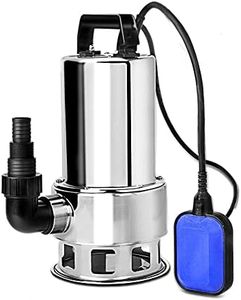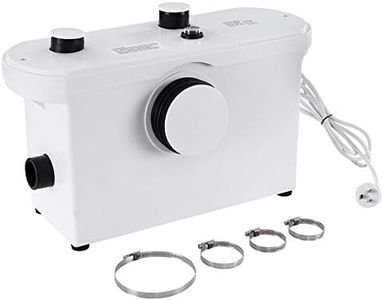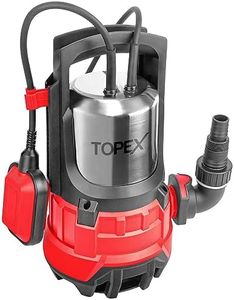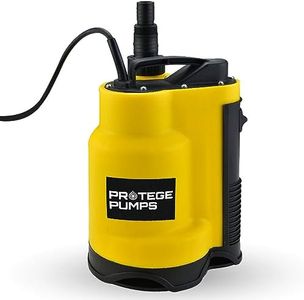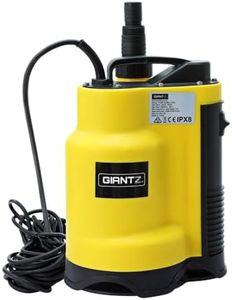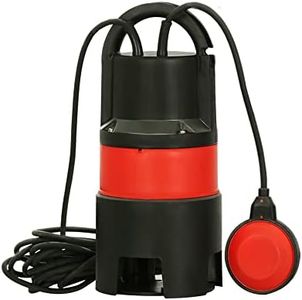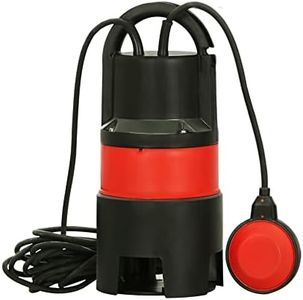We Use CookiesWe use cookies to enhance the security, performance,
functionality and for analytical and promotional activities. By continuing to browse this site you
are agreeing to our privacy policy
10 Best Sewage Sump Pump
From leading brands and best sellers available on the web.Buying Guide for the Best Sewage Sump Pump
Choosing the right sewage or sump pump is essential to protect your basement or property from water damage and sewage backups. The right pump will efficiently move unwanted water or waste away from your home, providing peace of mind and long-lasting reliability. Start by understanding the basic needs of your space—how much water or waste will the pump need to handle, how often will it run, what type of material does it need to move, and how far or high does it need to pump the liquid. Considering these questions will help you filter through the range of available pumps and focus on the features that matter most for your situation.Pump Type (Sump vs. Sewage)This spec refers to the main function of the pump. Sump pumps are designed to remove clear or slightly dirty water, such as basement groundwater or rainwater, while sewage pumps are built to handle solids and waste from toilets and similar sources. Picking the right type is essential: for flooding or water seepage, choose a sump pump; for waste and solid-laden liquids, choose a sewage pump. If your goal is to prevent basement flooding, a sump pump suffices. But if you have basement bathrooms or fixtures that produce waste, a sewage pump is necessary.
Horsepower (HP) or Power RatingHorsepower measures how powerful the pump's motor is, affecting how much water or waste it can move and how high it can pump it. Smaller spaces with less water to move can use smaller HP values, like 1/3 or 1/2 HP, while larger homes or more intense water issues may need 3/4 to 1 HP or more. When choosing, consider both the volume of water/waste and the vertical distance it must be pumped (called 'head height'). For light or occasional use, go with lower HP; for heavy, frequent demands or higher pumping needs, select higher HP.
Maximum Flow Rate (Gallons Per Hour/GPH or Gallons Per Minute/GPM)Flow rate shows you how much liquid the pump can move in an hour or minute. It's usually measured at a specified lift height and tells you how effective the pump is at clearing water or waste quickly. Lower GPH/GPM pumps, like those under 2,000 GPH, may work for small pits or minor flooding, whereas pumps capable of 3,000 GPH or more are better for larger basements or frequent issues. If you experience rapid flooding or have high water tables, choose a higher flow rate; for moderate or rare use, a mid-range flow rate is adequate.
Maximum Head (Lift Height)This value tells you how high the pump can raise water or sewage before it loses pressure and stops moving liquid. For most homes, this is the distance from your sump pit or sewage basin up to the ground level outflow pipe. If your home has deep basements or must pump uphill to a sewer line, look for pumps with greater maximum head ratings—often listed in feet. Measure the height from your pit to the discharge point and make sure your pump can handle at least that much, plus a little extra for safety.
Solid Handling CapabilityEspecially important for sewage pumps, this spec indicates the maximum size of solids (in inches or millimeters) the pump can handle without clogging. Basic sump pumps aren't built for solids, while sewage pumps can usually pass solids from 1 inch up to 2 or 3 inches. If your pump needs to move waste or debris, check this rating and ensure it's appropriate for your system—for example, residential toilets may require at least a 2-inch solid handling capability.
Switch Type (Float, Tethered, Vertical, Electronic)The switch determines how the pump turns on and off. Common types include float switches (which rise with water and trigger the pump), tethered switches (float at the end of a cable), vertical switches (move up with water in a guide), and electronic sensors (detect water level electronically). Float and vertical switches are reliable for most setups, while electronic switches can offer added precision. Choose based on your pit size and space: vertical or electronic switches suit narrow pits, while tethered floats are fine for larger basins.
Material and Build QualityPump components can be made of plastic, cast iron, or stainless steel. Cast iron and stainless steel are more durable and better for frequent or prolonged use, while plastic pumps are lighter and more affordable, best for occasional or emergency use. If your pump will run often, endure harsh environments, or move sewage, invest in stronger materials for longevity. For rarely used backup pumps, plastic may be sufficient.

